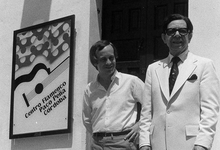User:Julia d.01/Andalusian Rock
Andalusian rock is a musical and cultural movement, that developed basically, though not exclusively, in Andalusia during the final years of the 1960s and the first half of the 1980s, framed in a widespread movement for the search for roots, which gave rise to the concept of Rock with roots. Although there were precedents in the compositions of Los Cheyenes or Los Brincos, it’s considered that the pioneers of the style were Smash, and Triana the most identifying band of the style, which combined flamenco with contemporary trends of progressive rock. Other examples of the genre were Veneno, Mezquita, Sabicas, Medina Azahara, Carmen, Cai, Granada, Imán, Guadalquivir, Alameda and Vega, among others.
Origins
[edit]
In Spain, the first notions of rock music tied to flamenco appeared at the end of the 1950s.[1] Soon, Spanish rock followed British patterns with few or anecdotal ties to Spanish folk music. The first attempts of standardizing and laying down flamenco rock beats came from Sevillian progressive rock bands of the late 1960s:[2] Gong, with Silvio Fernández and Luis Cobo "El Manglis"; Nuevos Tiempos, with Jesús de la Rosa and Rafael Marinelli; and, above all, Smash, la banda de Gualberto García y Julio Matito. Nevertheless, there were prior examples that had already incorporated flamenco nuances in a purely anecdotal way into pop-rock songs, like the song Flamenco by Los Brincos, recorded in 1964. There are also examples of an approach to Andalusian music in British rock, such as the songs Spanish Caravan (The Doors, 1968) y A Spanish Piece (Pink Floyd, 1969).
In the U.S prior to 1966, Spanish guitarist Sabicas had already made a record with Northamerican artist Joe Beck, published under the name Rock Encounter in 1970, in which it produced an unusual mix of flamenco and rock and where one can already observe a conscious pursuit of something new. The following year, he published another album of similar nature called The Soul of Flamenco and the Essense of Rock. It was that first record, according to Ricardo Pachón himself, which encouraged him to incorporate Manuel Molina to the band Smash and record five fusion tracks, among which were El garrotín, Tangos de Ketama, and Blues de la Alameda (1970), that unanimously are considered the beginning of the genre. Smash recorded two LPs, Glorieta de los lotos (Polygram ibérica, 1970) and We Come to Smash This Time (Polygram ibérica, 1971), full of brave ventures into the still unexplored lands of the fusion of rock and flamenco, leaving the terrain fertilized.
Apart from the aforementioned groups, the turn of the decade produced some records that contributed to Andalusian proto-rock: Opus Pi (1969), an LP of the band Taranto’s, integrated by members of Los Pekenikes and Los Pasos ;Tarantos (1971), by Madridnian band All & Nothing; Manuel Molina’s first solo single, La Mora/La primavera (EMI, 1971); etc.
1972-1975
[edit]ith the disappearance of those pioneering Andalucian rock bands the outlook appears, at the moment, sparse. The musicians of these formations are recomposed and seem to be groups that hardly have continuity. Julio Matito y La Cooperativa; Fly; Total (with Silvio and Antoñito “Smash”); Chicle, Caramelos, and Pipas (in which has Manuel Rodríguez and Marcos Manters), etc. None of them, however, continued to form clear lines opened to Andalusian Rock, except for Tartessos, a Huelvan band lead by guitarist and singer Pepe Roca, who edited various singles between 1973 and 1975, the year in which Phillips published their only LP, “Tiempo muerto”, with Manuel Marinelli still on the keyboards.
In 1972, the group Flamenco appeared, led by the Garrido Granados brothers, who continued the tradition of Gong and Smash, attaching rock music backdrops to flamenco songs, even though they added influences from Santana and glam rock.[3] Their first single, "Anda jaleo!/Corcho con corcho, caña con caña" (Ariola, 1972) is hardcore and Lorcanian. The second, from the same year, was signed by Paco de Lucía. In 1973, they published their first and only album, Flamenco, also in Ariola, which brought together the four already edited singles and the three new songs. They disappeared in 1976 after editing the other two singles, due to a bad contract. From a more pop perspective, the Almerían group Los Puntos, edited, in 1972, their famous “Llorando por Granada”, that is a progressive prelude of their final LP, “Oriental” (Polydor, 1977), symphonic and “Moorish”.
A year after, in 1973 Fandangos in the space was published in London by the band Carmen, a driven project by Mexican-Californian, David Clark Allen, in which John Glascock, ffuture bassist of Jethro Tull, also participated. An energetic ¡Ahora! opens the dramatic record where it fuses progressive virtuosity and Andalusian classics like “Anda jaleo!” that are worthy of their place in the pre-history of Andalusian Rock (prior to “El Patio”).

Around the middle of the decade, the Andalusian rock scene started to come alive. The group Estoques, a studio band, published in 1974 an interesting instrumental single, "Mezquita de Mohamed/Regreso a la ciudad", which opens the way to jazz rock for the genre and that, somehow, assumes the direct antecedent of bands like Guadalquivir or Vega. But, above all, Triana's first single ("Recuerdos de una noche/Luminosa mañana") is published, the paradigmatic band of the genre, opens the line of "symphonic andalusian rock". Garciapelayo, confirmed in an interview in Musical Express, that Triana was doing what King Crimson would do if he were from Seville.
[[Category:Flamenco-rock]]
[[Category:Andalusian music]]
[[Category:Articles with unsourced statements]]
- ^ "Las chicas que «inventaron» el rock and roll en España". 20 de septiembre de 2021. Retrieved 8 de febrero de 2022.
{{cite web}}: Check date values in:|access-date=and|date=(help) - ^ Carrasco 1977, pp. 7–9.
- ^ Clemente 2006, p. 15.
